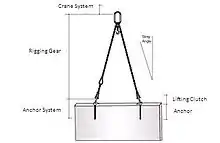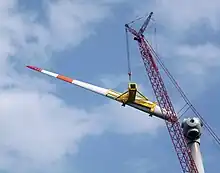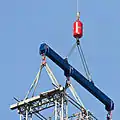Rigging (material handling)
Rigging is both a noun, the equipment, and verb, the action of designing and installing the equipment, in the preparation to move objects. A team of riggers design and install the lifting or rolling equipment needed to raise, roll, slide or lift objects such as heavy machinery, structural components, building materials, or large-scale fixtures with a crane, hoist or block and tackle.

Rigging comes from rig, to set up or prepare. Rigging is the equipment such as wire rope, turnbuckles, clevis, jacks used with cranes and other lifting equipment[1] in material handling and structure relocation. Rigging systems commonly include shackles, master links and slings, and lifting bags in underwater lifting.
In the United States the Occupational Safety and Health Administration (OSHA) regulates workplace safety including rigging in CFR 1926.251.[2]
Equipment
- Block (sailing) – Sailing term; single or multiple pulley
- Cargo net – Net used to secure or transfer cargo
- Cargo strap
- Chain – Series of connected links which are typically made of metal
- Chain hoist – Device used for lifting or lowering a load
- Chain stopper
- Come-along – Lever operated, portable ratchet winch
- Crane (machine) – Type of machine
- Crawler (rigging)
- Hook – Tool used to grab onto, connect, or attach to something
- Hoist (device) – Device used for lifting or lowering a load
- Jack (device) – Mechanical lifting device
- Knot – Method of fastening or securing linear material
- Lever – Simple machine consisting of a beam pivoted at a fixed hinge
- Lifting bag – Airtight bag used for underwater buoyant lifting when filled with air
- Link (chain) – Series of connected links which are typically made of metal
- Pry bar – Hand tool for prying boards and nails
- Rope – Length of braided strands
- Shackle – Metal assembly which functions as a removable connecting link
- Sheave – Wheel to support movement and change of direction of a taut cable
- Sheer legs
- Sling (rigging) – Rope, webbing, wire or chain used to support a load for lifting
- Spreader bar (rigging)
- Rope splicing – Semi-permanent joint between two ropes
- Tackle – System of two or more pulleys and a rope or cable
- Tirfor – Mechanical device that is used to adjust the tension of a rope
- Tugger (rigging)
- Turnbuckle – Device for adjusting the tension or length of ropes or cables
- Turning block
- Wire rope – Metal rope
- Winch
Gallery
 A Humvee is rigged for being airdropped at the Heavy Drop Rigging Facility near Pope Field at Fort Bragg, N.C.
A Humvee is rigged for being airdropped at the Heavy Drop Rigging Facility near Pope Field at Fort Bragg, N.C. The rigging is the two frameworks, spreaders, wire ropes and related fittings used by the crane to pick up this submarine.
The rigging is the two frameworks, spreaders, wire ropes and related fittings used by the crane to pick up this submarine. An advanced rigging challenge assembling a wind turbine.
An advanced rigging challenge assembling a wind turbine. An adjustable spreader bar with webbing slings.
An adjustable spreader bar with webbing slings.
See also
- Entertainment rigging – Setting up the equipment for a show
- Boat rigging – Setting up a rowing boat to accommodate the crew for rowing
- Parachute rigger – Person who is trained or licensed to pack, maintain or repair parachutes
- High lead logging – Method of cable logging using a spar, yarder and loader
References
- Vincoli, "Rigging". Jeffrey W.. Lewis' dictionary of occupational and environmental safety and health. Boca Raton: Lewis Publishers, 2000. Print.
- Reese, Charles D.. Annotated dictionary of construction safety and health. Boca Raton: Lewis Publishers, 2000. Print.